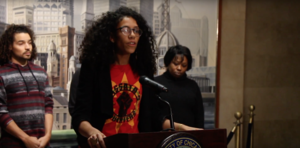Blind Trust: Who pays for what no one wants?
PERSPECTIVE: As City Council continues with the controversial Joint Public Safety Training Academy, an important question remains unanswered: Where’s the money for it coming from?
A joint campaign of various grassroots organizations, residents of West Garfield Park and even Chance the Rapper, #NoCopAcademy aims to stop the construction of the proposed Joint Public Safety Academy, with its price conservatively estimated to be $95 million.
A timeline of the academy made by the organizers shows that initial development for the project was mostly been hidden from the public. When RCY interviewed community members and organizers at a press conference, they told us many residents in Garfield Park weren’t consulted until well after the announcement. Those who were told about the academy thought it would only train firefighters — not the police. When those same community members brought their concerns before City Council, they were ignored and the initiative moved forward.
In the press release announcing the plans for the academy, Mayor Rahm Emanuel claimed that the Chicago Infrastructure Trust (CIT) would work alongside City Council to select a developer to design, finance and build the project. According to the Sun-Times, $20 million will come from an earlier land sale, and $28 million from sales of other city assets, leaving $37 million left up to the trust. CIT’s involvement is odd, to say the least. The organization’s major focus is infrastructure, both physical and social, but funding police facilities doesn’t fit with their history. Additionally, Chicago already has an agency to handle construction projects — the Public Building Commision.
So why is CIT involved?
First, some background
In 2012, Rahm Emanuel announced a new program to revitalize Chicago’s infrastructure: the Chicago Infrastructure Trust. Alongside former President Bill Clinton, Emanuel lauded the trust as the future of public infrastructure funding, a way for the city to essentially have their cake and eat it too by convincing private sector investors to fund the construction of city infrastructure projects and take some of the pressure off of the city. Initial major investors claimed to a have an investment capacity of $1 billion for projects the trust took on.
Source: chicagoinfrastructure.org
In an executive ordinance, CIT was created as an independent entity that would broker deals with the private sector to pay for necessary improvements regarding both “hard” infrastructure and “soft” infrastructure; “hard” meaning the physical structures involved with everything from transportation to energy efficiency and “soft” referring to the underlying organizational structures of government and cultural institutions.
So rather than raising and creating more taxes or utilizing more city bonds, the trust would negotiate with the private sector to make up for the lack of funds from public sources. The trust is expected to negotiate deals with corporations to design, finance and construct projects, returning investments through city savings and other sources.
The reality is a bit messier than that.
According to an investigation by Project 6, CIT’s first major project, Retrofit One was a huge fumble.
At its core, Retrofit One was supposed to make energy improvements to municipal buildings using the trust’s private financing model. The trust was expected to raise between $200–225 million for the project, offering investors energy savings in over 1,000 municipal buildings as a way to recoup their investment.
But issues plagued the project from the beginning.
First of all, CIT raised only $13.5 million with a private loan from Bank of America after failing to meet the projected $225 million in private funding. So the project was scaled back from over 1,000 buildings to a paltry 60 for $19 million.
The Harold Washington Library
Second, bank loans need physical collateral, so the trust offered up all the equipment installed. Should the trust default on the loan, light fixtures, window and door fittings, heat, ventilation and cooling systems in 60 city-owned buildings would be repossessed. Not only are city buildings places where citizens spend time such as the Harold Washington Library, they also function as heating and cooling centers for the poor and homeless during winter and summer months. So some of the city’s most vulnerable citizens and city employees were essentially put up as collateral. When questioned by City Council about the terms of the loan, trust finances and responsibility should the trust default on the loan, city Chief Financial Officer Carole Brown said she was “not aware” of city properties that were on lien and would verify with the trust. There is no record of her following up.
Finally, that $19 million the city spent on installation? It was for less than $10 million worth of equipment. In 60 buildings. This was supposed to save the city $1.4 million per year in energy costs, and for 15 years, all those savings will go to paying off the Bank of America loan. The loan agreement also prevents the city from replacing the equipment without written permission from Bank of America; by the time the city can reap any rewards for the project, all the equipment will be woefully out of date.
Retrofit One finished in 2014 and showed how shaky CIT’s model is, how opaque it’s operating principles are and the risks of funding municipal projects with private investors.
A watchdog out the door
After Retrofit One, CIT was silent for nearly a year. After finishing the project, the trust didn’t publicly meet for 10 months. No other projects materialized (there were rumblings of an Uptown Theatre rebuild) and the organization struggled on a tight budget of public funding, sometimes more than a month late on paying employees according to BGA. Nearly a year of silence and no new projects later, Rahm rebooted the trust in August 2015.
The Tribune’s coverage of the restructure shows how nearly the entire board was turned over to a variety of big shots and Rahm favorites, including City Treasurer Kurt Summers and new executive director Leslie Darling. Summers and Darling, along with various members of the new board, have worked alongside the mayor or supported him in campaign donations; however, the most important change was the elimination of City Inspector David Hoffman, whose presence quelled some fears from alderman of opacity in the trust’s operations.
CIT is not required to follow Illinois’ open record laws; the ordinance forming the trust uses creative language to just suggest it. It reads:
“The Trust has in place procedures for providing public access to books, records, minutes and documents, that are comparable to the Illinois Freedom of Information Act, 5 ILCS l40lI et seq., as now enacted or as hereafter amended (“FOIA”).”
The only major scrutiny the trust has is an independent financial advisor, also required by skeptical alderman before they approved the creation of the trust. However, the advisor only provides a report to the City Council and the public annually. So at meetings, Hoffman’s detailed questioning stood in contrast to other members’ rare offerings. He called for transparency and clarity in how funding would work for CIT, even threatening to vote against Retrofit One unless the project was properly vetted. He functioned as a watchdog for the trust.
According to the Tribune, when Hoffman left he stated, “If the trust keeps a reasonably conservative approach that protects city taxpayers, only considers deals where the purpose is to improve city infrastructure rather than raise funds, doesn’t rush based on political pressures and ensures transparency by having a full public discussion of the details and potential risks sufficiently in advance so people can consider it, then I’m confident it will find other prudent deals in the future.”
CIT’s major focus now is the Chicago Smart Lighting Project. The project is another shot at making the city more green and “smart” by modernizing the city’s aging infrastructure. Reporting by Tribune reporters describes the $160 million lighting project as an initiative to replace the city’s 270,000 high-pressure sodium streetlights with new energy-efficient LEDs. Per usual, concerns have been raised as to how the trust plans to finance the project.
Ald. Scott Waguespack, 32nd, told reporters, “I’m kind of finding it hard to believe we sat there with all these people in the Infrastructure Trust and no one can give us a specific breakdown…over the next four or five years so that we know how to budget for it and it’s not sort of, ‘Let’s play it by ear and see what happens next year.’”
Initially, the project was intended to be funded by a private investor; however Executive Director Darling said the city had conflicts handing over the lights.
“Private investors were very interested, (but) the city wasn’t interested in privatizing a critical public safety asset.”
The Smart Lighting project also carries concerns about privacy. The lights are intended to initially be installed in neighborhoods with “heightened public safety concerns,” a city press release stated; more specifically, marginalized and over-policed communities on the South and West sides, such as Garfield Park, North Lawndale, and Englewood.
"to…enhance the ability to mount security cameras and other peripherals.”
CHICAGO SMART LIGHTING RFI
In CIT’s Request for Information for the project, the trust explicitly “welcomes suggestions for redesigned pole types and pole spacing in order to…enhance the ability to mount security cameras and other peripherals,” implying these communities would be susceptible to increased surveillance and monitoring in the name of “public safety.”
It’s a flaw inherent to the trust’s model: do we want to surrender the city’s infrastructure to private investors, if they can even find them? What happens if the smart lighting project can’t come up with the funds for next year? Does the city search out a private investor to raise funds? And why should infrastructure improvements come with increased surveillance?
Render of the academy via chicagopolice.org
Is a police academy infrastructure?
CIT’s new projects are a sign of mission drift: its focus is moving from city infrastructure to “public safety” without any care for funding and public opinion. Well ahead of the completion of the Smart Lighting project, CIT was brought in on the Joint Public Safety Training Academy.
The Academy is a rushed response to the Department of Justice investigation on racial discrimination and violence in the Chicago Police Department; its process began only four months after the report was published. In the report, the DoJ provides around 100 points of improvement for the City and CPD, but only one is dedicated to facilities like academies.
The rest is dedicated to pointing out that CPD needs more cultural and training content reforms instead of physical facilities. The academy has also been criticized by residents, organizers, and watchdogs like BGA for its price and impact on West side neighborhoods.
The issues with the academy are social, economic and political, so why does an infrastructure organization want anything to do with it? Of course, Rahm wants his project to shine whenever it can, but brokering deals for such a volatile issue flies in the face of Hoffman’s advice.
The trust hasn’t provided meeting minutes since June 2017, when they had their annual audit. No public discussion of the academy is available from CIT, though the trust held a networking meeting only for pre-registered contractors and continues to push forward. The presentation is available here.
The trust should be focused on transparency and community-centered projects in order to function as a municipal funding source. Its move into “public safety” and its continued opacity, takes it into dangerous waters: if a mysterious private investor pays for the police, then who controls the police?
CIT’s funding strategy hasn’t proven itself capable of an initiative of this size and without a watchdog on the board, who knows how transparent and honest the trust will be about its spending?
The problems with the Chicago Infrastructure Trust are clear: It’s never really clear what’s happening and it’s much more expensive than traditional funding methods. Giving private investors control over infrastructure moves the public out of the picture. Infrastructure improvements shouldn’t involve more surveillance and police. And who pays for something no one wants?










